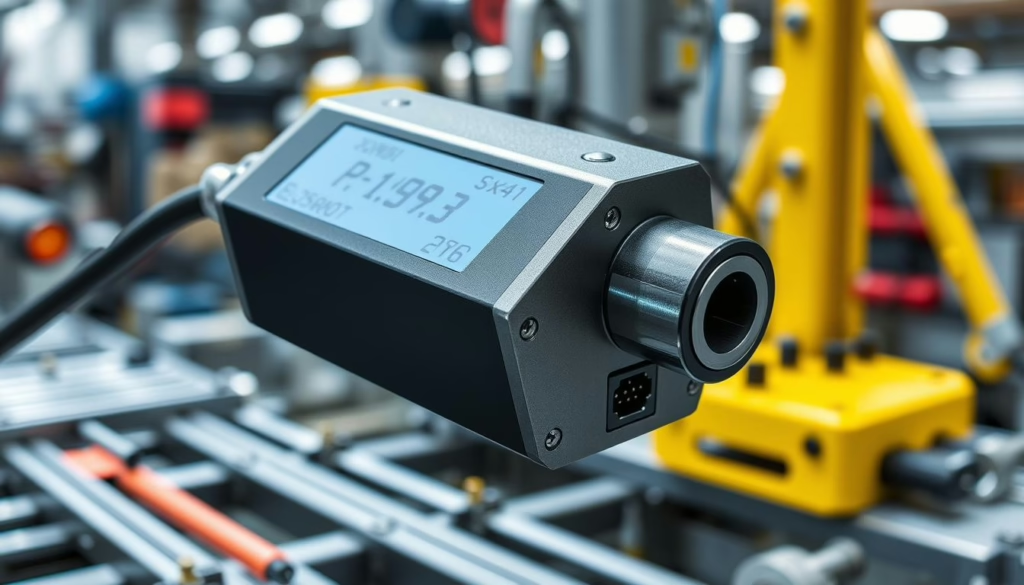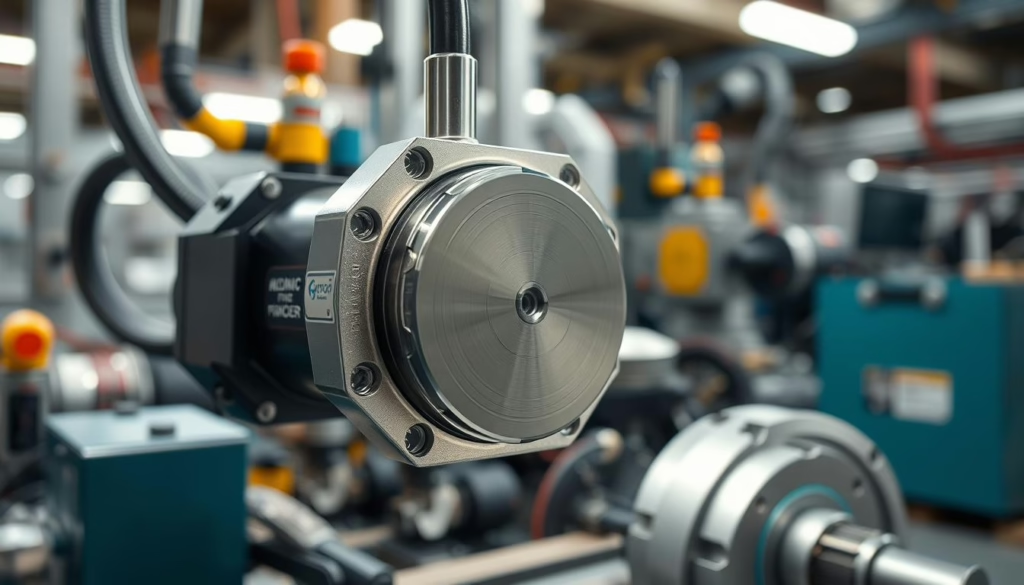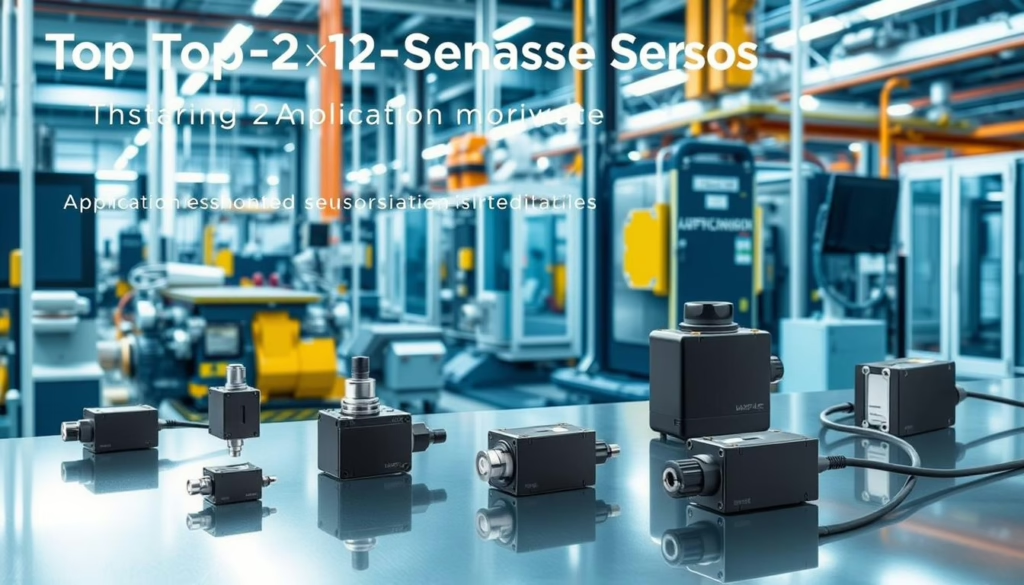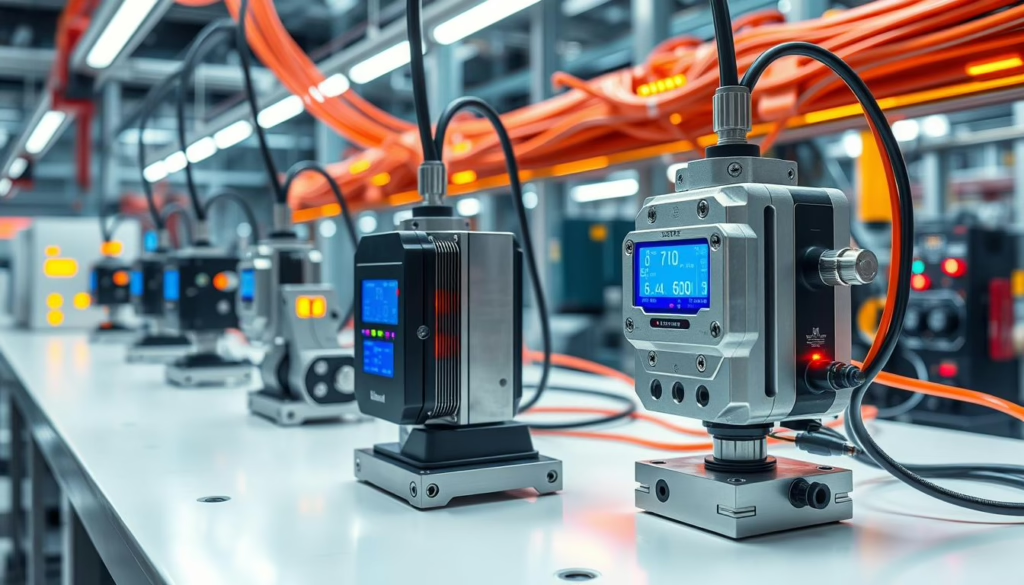In industrial settings, accurately measuring force is key. We explore the top 2 axis force sensors, critical for high-accuracy needs. 2 axis force sensor for industrial. They assure top-notch performance for manufacturing and quality checks.
Key Takeaways
- 2 axis force sensors deliver high precision force measurement critical for industrial applications.
- Industrial-grade sensors offer durability required in demanding environments.
- They enhance performance in manufacturing and quality control.
- Advanced technological integration ensures robust and accurate measurements.
- A thorough understanding of key features helps in selecting the best sensor for specific needs.
- Consider reliability, durability, and cost-effectiveness when choosing a sensor.
Introduction to 2 Axis Force Sensors
Force measurement technology is key in today’s industries. It helps achieve precision and automated control. Let’s explore what 2 axis force sensors are and why they matter in industrial automation.
What Are 2 Axis Force Sensors?
2 axis force sensors measure forces in two directions. They change mechanical force into electrical signals. This helps with accurate, real-time data collection. It’s vital for monitoring and control in tough industrial settings.
Importance in Industrial Applications
2 axis force sensors are crucial for industrial automation. They give important data on load and force. This improves feedback and boosts system efficiency.
By using these sensors, industries gain better production control. This leads to better quality and performance.
Force measurement tech, especially 2 axis force sensors, is central to evolving industrial automation. They’re used in everything from engineering precision to quality control. This makes them essential in today’s production scenes.
Key Features of the Best 2 Axis Force Sensors
When picking the best 2 axis force sensors, a few key features matter a lot. These sensors can detect force accurately in two directions. This makes them key in automation and testing materials.
Their rugged sensor design is another important feature. They are made tough to last in harsh places. This toughness helps them work well always, making them dependable for businesses.
The sensors can also do multiple tasks at once. They measure different forces at the same time. This makes them more useful and efficient for industrial uses.
A top maker of these sensors is XJCSENSOR. They are known for precise and reliable sensors. Their 2 axis force sensors are customizable and use advanced tech. This makes them very valuable in robotics and automation.
| Feature | Benefit |
|---|---|
| Accurate Force Detection | Ensures high precision in tasks |
| Rugged Sensor Design | Maintains performance in harsh environments |
| Multitasking Capabilities | Enables simultaneous measurement of different force vectors |
These sensors improve control and efficiency in operations. They also bring the needed reliability for crucial tasks. Buying high-quality 2 axis force sensors boosts accuracy and performance.
Benefits of Using 2 Axis Force Sensors in Industrial Automation
Using 2 axis force sensors in industrial automation offers big benefits. They boost operational efficiency and the quality of products. These sensors are key in getting accurate force measurements, crucial in many industrial tasks.
Enhanced Precision
Adding 2 axis force sensors to systems brings high accuracy in force measurement. This is vital across many applications. It cuts down errors in production. This is key to keeping products top-quality and making automation more efficient.
Improved Process Monitoring
These sensors give real-time data that betters process monitoring. With ongoing feedback, adjustments can be made right away. This keeps production steady and efficient. It also cuts down waste and improves performance. This shows how crucial precision force measurement is for top automation efficiency.
Quality Control Advancements
2 axis force sensors are a big help in advancing quality control. They give accurate, real-time data. This helps spot defects early in making products. This feedback ensures only the best products go to market. Hence, quality control sensors in these systems are key in keeping products perfect and customers happy.
| Benefit | Description |
|---|---|
| Enhanced Precision | High precision force measurement minimizes errors, maintaining quality standards |
| Improved Process Monitoring | Real-time data allows consistent and efficient adjustments, reducing wastage |
| Quality Control Advancements | Accurate data ensures defects are identified early, maintaining product integrity |
Top 2 Axis Force Sensor for Industrial Applications
Choosing the right 2 axis force sensor is crucial. We provide detailed overviews and comparisons of top sensors. This helps industry experts make the best choices for their needs.
Overview of Leading Models
Futek, Honeywell, and TE Connectivity are among the top sensor brands. Each offers distinct features. These improve performance in different industrial settings.
- Futek LSB302: Known for its high accuracy and compact design, making it ideal for tight spaces.
- Honeywell FSS-SMT: Boasts superior durability and a wide range of force measurement.
- TE Connectivity FX1901: Offers excellent sensitivity and robust construction for heavy-duty applications.
Comparison and Analysis
We provide a table to compare top models by accuracy, range, durability, and application fit. This helps in thorough analysis.
| Model | Accuracy | Force Range | Durability | Ideal Applications |
|---|---|---|---|---|
| Futek LSB302 | High | 0-10 lb | Moderate | Robotic arms, precision engineering |
| Honeywell FSS-SMT | Moderate | 0-5 lb | High | Harsh environments, heavy machinery |
| TE Connectivity FX1901 | Moderate | 0-20 lb | High | Industrial automation, load measurement |
Our analysis highlights the unique advantages of each sensor. It guides industry leaders to pick the best one for their needs. By comparing these sensors, decision-makers can find the ideal 2 axis force sensor for their applications.
Role of Load Cells and Strain Gauges in Force Measurement
Load cells and strain gauges are key in force measurement. Together, they transform physical force into an electrical signal. This ensures precision in industrial uses.
Load cells have special strain gauge sensors. These sensors are attached to the load cell’s body. When the force changes, so does the strain gauge’s electrical resistance. This tiny change turns into a signal we can read. The teamwork between load cells and strain gauges drives accurate measurements.
In industry, reliable load cell technology is essential. It helps keep high standards. The sensors work together for reliability, reducing errors. With new components, equipment works better. This improves monitoring and quality control.
Load cells and strain gauges are crucial for force measurement. They boost sensor system performance. This leads to better industrial solutions. Learning about them shows their value and need in the industry.
Why Choose XJCSENSOR for Your Industrial Needs
The XJCSENSOR edge comes from its firm commitment to trusted sensor solutions and top-notch customer service. This dedication to quality and service marks us as leaders in the field. This is shown through our wide client base and the reliability of our products.
Company Background
XJCSENSOR, with years of sensor industry experience, stands as a dependable source of cutting-edge sensor technology. Our legacy is rooted in innovation, quality, and a focus on our customers. This culture ensures we always deliver excellent service.
Product Reliability
At the heart of XJCSENSOR’s offerings is reliability. Our sensors, like the well-regarded 2 axis force sensors, meet the highest standards for accuracy and durability. This reliability is key to the XJCSENSOR edge. It ensures our clients get trusted solutions that boost their efficiency.
Customer Support
Top-tier customer service is key to how we do business. We put our clients first, offering wide-ranging support from choosing products to technical help. Our support team is always on hand to offer insights and solutions. They ensure our customers have a great experience from beginning to end.
| Feature | Description |
|---|---|
| Industry Experience | Decades of expertise in developing advanced sensor technologies. |
| Product Reliability | High standards of accuracy and durability in all sensor products. |
| Customer Support | Comprehensive support from product selection to technical assistance. |
Applications of 2 Axis Force Sensors in Precision Engineering
2 axis force sensors are changing the game in precision engineering. They are especially important in the world of robotic technologies and integrating systems. These sensors help make various industrial tasks more precise and efficient.
Robotic Applications
Robotic technologies get a big boost from 2 axis force sensors. With these sensors, robots can do delicate and complex tasks very accurately. For example, on assembly lines, robots with these sensors handle parts gently. This reduces damage and raises the quality of the final product.
Integration in Automated Systems
Adding 2 axis force sensors to automated systems makes manufacturing better. These sensors provide important real-time data needed for integrating systems. They help different parts of a system work together smoothly. This increases efficiency, lowers downtime, and boosts productivity.
The importance of 2 axis force sensors in precision engineering is huge. They play a key role in innovating robotic technologies and in integrating systems. This drives progress and efficiency in many industries.
Factors to Consider When Selecting a 2 Axis Force Sensor
When picking a 2 axis force sensor, it’s crucial to look at key criteria to make sure you get the best value and performance. This guide points out must-know factors like how accurate it is, how long it lasts, and if it’s worth the cost.
Accuracy and Precision
Getting accurate and precise readings is a top priority. These features make sure the sensor gives trustworthy and consistent data. Checking how the manufacturer calibrates the sensor and its performance details can reveal its ability to stay precise over time.
Durability and Material
In tough industrial settings, a sensor’s toughness and the material it’s made from are very important. Choosing sensors made with strong materials like stainless steel or titanium helps them resist damage and corrosion. This means they work well for a longer time.
Cost-effectiveness
It’s key to find a balance between cost and quality when choosing a sensor. Think about not just the buy price but also the value over time. This includes how much it costs to keep up, its lifespan, and the cost to integrate it into your system. Spending a bit more at first for a sensor that lasts and performs better can save money down the road.
Installation and Maintenance Tips for 2 Axis Force Sensors
Properly installing and maintaining 2 axis force sensors is key. This ensures they work accurately and last longer. Follow a good guide for setup and take care of them well for the best performance and trustworthiness.
- Location and Orientation: Pick a stable spot without vibration for the sensor. Make sure it’s set up the way the maker says.
- Wiring: Be careful connecting wires. Check that all links are tight and clear of signal interference.
- Calibration: Calibrate the sensor after you put it in. This is a must for accurate measurements and correct function.
Maintenance Best Practices:
- Routine Inspections: Look at the sensors often. Watch for wear, rust, or loose connections.
- Cleaning: Use the right stuff to clean sensors. Stay away from strong chemicals that could hurt them.
- Software Updates: Keep the sensor software up to date. This adds new features and improvements.
It’s crucial to follow a complete guide for setting up sensors and stick to care tips. This makes 2 axis force sensors work well for a long time. Doing this keeps them in good shape, avoiding extra costs and the need to get new ones.
If you need high-quality and precise force sensors, check out what XJCSENSOR offers. They’re a top choice for industrial force measurements because of their accuracy and dependability.
Conclusion
In the world of industry, 2 axis force sensors are key. We’ve seen how they work, their benefits, and where they’re used. They are crucial for precision, quality control, and better process monitoring. These sensors help make industrial processes modern and efficient.
Looking ahead, using the best 2 axis force sensors will push industries forward. Brands like XJCSENSOR offer top reliability and support. It is vital to choose a sensor that is accurate, long-lasting, and cost-effective. This ensures your operations run smoothly.
To conclude, adding 2 axis force sensors to industries is a move toward future tech. It shows a commitment to smart industrial solutions. As technology grows, these sensors will lead the way. They bring efficiency and precision to every area they’re used in.






